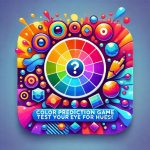As an investment strategy in the financial markets, color trading is purely theoretical. Stocks, bonds, commodities, currencies, and derivatives are among the assets traded on traditional financial markets. These assets are exchanged according to a variety of criteria, including their market value, company performance, economic indicators, and market trends. Colors are occasionally used in real financial markets to indicate various data types or trends on graphs and charts.
Green, for instance, might denote upward price movements while red might denote downward ones. This is not a basis for trading decisions, though; it is only for visual representation. To make wise decisions, legitimate investment strategies use technical analysis, fundamental analysis, and a variety of economic indicators. These techniques entail examining market patterns, financial statements, economic data, & other pertinent details in order to evaluate the possible worth and hazards of investments.
Investors should be aware that there are no tricks or unusual strategies—like color trading—that can ensure success in the financial markets. Education, investigation, and a thorough comprehension of market dynamics and hazards are necessary for responsible investing. Recognizing Associations of Colors.
When trading based on color movements, traders can make better decisions if they are aware of these psychological associations. Traders can more accurately predict market reactions and make more calculated trading decisions by identifying the emotional reactions that are elicited by various colors. Technical Evaluation in Color Trading. Technical analysis is a tool used by traders to find patterns and trends in color movements, in addition to psychology. In order to analyze color charts and forecast future price movements, this requires utilizing a variety of tools and indicators.
Traders can obtain important insights into future market trends by examining past price data & spotting patterns in color movements. blending technical analysis & psychology. All things considered, assessing market trends in color trading necessitates a combination of employing technical analysis tools & comprehending color psychology. Traders can gain a deeper comprehension of market trends and improve their decision-making by taking into account both the technical aspects of charting and the psychological influence of colors. In order to recognize possible market trends & make wise trading decisions, color traders must make use of color patterns & charting techniques.
To evaluate color charts and spot patterns that can help forecast future price movements, traders employ a variety of tools and indicators. Through the examination of past price data and the recognition of recurrent trends in color movements, traders can acquire significant knowledge regarding possible market trends. The open, high, low, and close prices for a given period are displayed on candlestick charts, which are a popular charting method in color trading.
Traders utilize these charts to spot patterns that can offer important insights into future market trends, such as hammer, doji, & bullish or bearish engulfing patterns. Color patterns are another tool used by traders in addition to charting techniques to spot possible market trends. Through observing the relationships between colors and their temporal evolution, traders can discern trends that might suggest advantageous times to buy or sell.
Traders can gain a deeper comprehension of market trends & improve their decision-making by integrating color pattern analysis with charting techniques. To minimize loss potential and optimize profit potential, color trading requires the application of risk management techniques, just like any other type of trading. Color traders frequently employ stop-loss orders to reduce possible losses on a trade as a risk management tactic. Traders can limit their exposure to possible losses by setting a preset price at which a trade will automatically close. Diversification, which entails distributing investments across several colors or markets to lower overall risk, is another risk management technique used in color trading.
Traders can lessen the impact of unfavorable price movements in any one color or market by diversifying their holdings. Also, one more crucial risk management tactic in color trading is position sizing. Traders can reduce potential losses while maximizing profit potential by carefully calculating the size of each position based on variables like risk tolerance and market conditions.
In general, color trading requires the application of risk management techniques in order to minimize potential losses & optimize profit potential. Through the implementation of strategies like stop-loss orders, diversification, & position sizing, traders can proficiently mitigate risk and enhance their overall trading ROI. Color trading is heavily reliant on technology, which gives traders access to sophisticated tools and resources that enable them to assess market trends and make more intelligent trading choices. The ability to analyze historical price data & spot patterns in color movements is made possible by sophisticated charting software, which is a crucial piece of technology in color trading.
Traders utilize technological tools such as charting software, real-time market data, and news updates to influence color movements. A trader’s ability to determine when to enter or exit a trade based on color movements can be enhanced by keeping up to date on market developments and current events. Through online trading platforms, technology Also helps traders to execute trades quickly and effectively. These platforms give traders access to a variety of markets and colors, enabling them to take advantage of opportunities as they present themselves.
In general, color trading requires utilizing technology to gain access to sophisticated tools for assessing market trends, remaining up to date on current affairs, & placing trades quickly. Applying Mean Reversion and Trend Following. Trend following is an advanced strategy that entails spotting established patterns in color movements & profiting from them by making trades that move in the trend’s direction. Identifying overbought or oversold conditions in color movements & entering trades with the expectation that prices will eventually revert to their average is known as mean reversion, which is another advanced strategy.
Trade using algorithms. Advanced color traders may also employ algorithmic trading strategies, which entail the use of computer algorithms to carry out trades in accordance with preset standards. These algorithms provide traders a competitive edge in the market by swiftly analyzing vast volumes of data and precisely executing trades.
Optimizing Potential Profit. Ultimately, by utilizing algorithmic trading techniques, recognizing overbought or oversold conditions, and capitalizing on established trends, advanced color trading strategies can help seasoned traders maximize profit potential. A combination of technical proficiency, market awareness, and successful risk management techniques are needed to maximize profit potential in color trading. Keeping up with current affairs & market trends that may have an impact on color movements is essential for optimizing profit potential.
Traders can make better decisions about when to enter or exit trades based on color movements by keeping up to date on factors like economic indicators, geopolitical events, and industry news. Acquiring an in-depth knowledge of color psychology and its ability to impact market trends is another way to optimize profit potential. Trades can be entered or exited based on color movements, and traders can make better decisions by knowing the psychological effects of colors on consumer behavior & market sentiment.
To maximize profit potential in color trading, however, one must employ effective risk management techniques. Traders can minimize loss potential and maximize profit potential by employing strategies like stop-loss orders, diversification, and position sizing. To optimize earnings from color trading, one must comprehend color psychology, keep up to date on current affairs, & employ efficient risk control techniques.
Trader performance can be enhanced and profit potential can be maximized by combining these components with technical proficiency and market knowledge.


